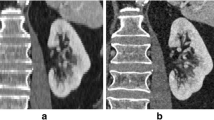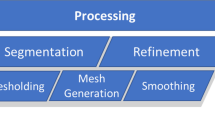Abstract
Additive manufacturing and bio-printing, with the potential for direct fabrication of complex patient-specific anatomies derived from medical scan data, are having an ever-increasing impact on the practice of medicine. Anatomic structures are typically derived from CT or MRI scans, and there are multiple steps in the model derivation process that influence the geometric accuracy of the printed constructs. In this work, we compare the dimensional accuracy of 3-D printed constructs of an L1 vertebra derived from CT data for an ex vivo cadaver T-L spine with the original vertebra. Processing of segmented structures using binary median filters and various surface extraction algorithms is evaluated for the effect on model dimensions. We investigate the effects of changing CT reconstruction kernels by scanning simple geometric objects and measuring the impact on the derived model dimensions. We also investigate if there are significant differences between physical and virtual model measurements. The 3-D models were printed using a commercial 3-D printer, the Replicator 2 (MakerBot, Brooklyn, NY) using polylactic acid (PLA) filament. We found that changing parameters during the scan reconstruction, segmentation, filtering, and surface extraction steps will have an effect on the dimensions of the final model. These effects need to be quantified for specific situations that rely on the accuracy of 3-D printed models used in medicine or tissue engineering applications.



Similar content being viewed by others
References
Hopkinson N, Hague R, Dickens P: Rapid manufacturing: an industrial revolution for the digital age: Wiley, 2006
Giannatsis J, Dedoussis V: Additive fabrication technologies applied to medicine and health care: a review. Int J Adv Manuf Technol 40:116–27, 2009
Bibb R. Medical modelling: the application of advanced design and development techniques in medicine: Woodhead Publishing, 2006
Gibson I. Advanced manufacturing technology for medical applications: reverse engineering, software conversion and rapid prototyping: Wiley, 2006
Rengier F, Mehndiratta A, von Tengg-Kobligk H, Zechmann CM, Unterhinninghofen R, Kauczor H-U, Giesel FL: 3D printing based on imaging data: review of medical applications. Int J Comput Assist Radiol Surg 5:335–41, 2010
Bibb R, Eggbeer D, Evans P: Rapid prototyping technologies in soft tissue facial prosthetics: current state of the art. Rapid Prototyp J 16:130–7, 2010
Bibb R, Eggbeer D, Evans P, Bocca A, Sugar A: Rapid manufacture of custom-fitting surgical guides. Rapid Prototyp J 15:346–54, 2009
Cao Y, Vacanti JP, Paige KT, Upton J, Vacanti CA: Transplantation of chondrocytes utilizing a polymer-cell construct to produce tissue-engineered cartilage in the shape of a human ear. Plast Reconstr Surg 100:297–302, 1997
Weng Y, Cao Y, Arevalo C, Vacanti MP, Vacanti CA: Tissue-engineered composites of bone and cartilage for mandible condylar reconstruction. J Oral Maxillofac Surg 59:185–90, 2001
Ballyns JJ, Gleghorn JP, Niebrzydowski V, Rawlinson JJ, Potter HG, Maher SA, Wright TM, Bonassar LJ: Image-guided tissue engineering of anatomically shaped implants via MRI and micro-CT using injection molding. Tissue Eng A 14:1195–202, 2008
Khalyfa A, Vogt S, Weisser J, Grimm G, Rechtenbach A, Meyer W, Schnabelrauch M: Development of a new calcium phosphate powder-binder system for the 3D printing of patient specific implants. J Mater Sci Mater Med 18:909–16, 2007
Starosolski ZA, Kan JH, Rosenfeld SD, Krishnamurthy R, Annapragada A: Application of 3-D printing (rapid prototyping) for creating physical models of pediatric orthopedic disorders. Pediatr Radiol 44:216–21, 2014
Boedeker KL, Cooper VN, McNitt-Gray MF: Application of the noise power spectrum in modern diagnostic MDCT: part I. Measurement of noise power spectra and noise equivalent quanta. Phys Med Biol 52:4027, 2007
Boedeker K, McNitt-Gray M: Application of the noise power spectrum in modern diagnostic MDCT: part II. Noise power spectra and signal to noise. Phys Med Biol 52:4047, 2007
Ogden K, Ordway N, Diallo D, Tillapaugh-Fay G, Asian C: Dimensional accuracy of 3D printed vertebra. SPIE Medical Imaging: International Society for Optics and Photonics, 2014, pp. 903629–903629
Whyms BJ, Vorperian HK, Gentry LR, Schimek EM, Bersu ET, Chung MK: The effect of computed tomographic scanner parameters and 3-dimensional volume rendering techniques on the accuracy of linear, angular, and volumetric measurements of the mandible. Oral Surg Oral Med Oral Pathol Oral Radiol Endod 115(5):682–691, 2013
Panjabi MM, Takata K, Goel V, Federico D, Oxland T, Duranceau J, Krag M: Thoracic human vertebrae quantitative three-dimensional anatomy. Spine 16:888–901, 1991
Analyze 11.0 Help File, Tiling Parameters. AnalyzeDirect Inc., Overland Park, KS, 2014
Lorensen WE and Cline HE: Marching cubes: a high resolution 3D surface construction algorithm. Comput Graph, 21(4), 1987
Author information
Authors and Affiliations
Corresponding authors
Rights and permissions
About this article
Cite this article
Ogden, K.M., Aslan, C., Ordway, N. et al. Factors Affecting Dimensional Accuracy of 3-D Printed Anatomical Structures Derived from CT Data. J Digit Imaging 28, 654–663 (2015). https://doi.org/10.1007/s10278-015-9803-7
Published:
Issue Date:
DOI: https://doi.org/10.1007/s10278-015-9803-7




